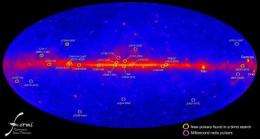Fermi Large Area Telescope reveals pulsing gamma-ray sources

Scientists at the Naval Research Laboratory (NRL) Space Science Division and a team of international researchers have positively identified cosmic sources of gamma-ray emissions through the discovery of 16 pulsating neutron stars. Using the Large Area Telescope (LAT), the primary instrument on NASA's Fermi Gamma-ray Space Telescope satellite, the discoveries were made by conducting blind frequency searches on the sparse photon data provided by the LAT.
The photons had energies between 20 Mega-electron-volts (MeVs) and 300 Giga-electron-volts (GeVs)— tens of millions to hundreds of billions of times more energetic than the photons we see with the human eye.
A second study, published at the same time, announced the detection of gamma-ray pulsations from eight Galactic millisecond pulsars (MSPs). Millisecond pulsars spin hundreds of times per second, but have magnetic fields 10,000 times lower than normal pulsars. These discoveries confirm that they, too, can produce powerful gamma-ray emissions.
"Fermi has truly unprecedented power for discovering and studying gamma ray pulsars," said Paul Ray astrophysicist, Naval Research Laboratory. "Since the demise of the Compton Gamma Ray Observatory a decade ago, we've wondered about the nature of unidentified gamma-ray sources it detected in our galaxy. These studies from Fermi lift the veil on many of them."
Pulsars are rapidly rotating, highly magnetized neutron stars that can emit radiation across the electromagnetic spectrum. Prior to the launch of Fermi, gamma-ray pulsations were only detected from pulsars previously discovered using radio or X-ray telescopes. Radio telescopes can detect pulsars only if one of the narrow radio beams is directly aimed at the telescope; otherwise the pulsar can remain hidden. The much broader gamma-ray beams allowed the new pulsars to be discovered as part of a comprehensive search for periodic gamma-ray emission using five months of Fermi LAT data and new computational techniques.
The newly discovered pulsars, with rotation periods that range from 48 to 444 milliseconds, help reveal the geometry of emission from rotation-powered pulsars and provide valuable information on population statistics, the energetics of pulsar wind nebulae and supernova remnants. A wide variety of astrophysical phenomena, such as pulsars, active galactic nuclei, gamma-ray bursts and some binary star systems are known to produce photons exceeding many MeVs.
"The Fermi LAT makes it possible for us to pinpoint neutron stars," said Eric Grove, astrophysicist and LAT Commissioner, NRL Space Science Division. "The combination of a very large collecting area, large field of view, and precision timing from an on-board Global Positioning System receiver enables the LAT to see sources that were far beyond the reach of previous gamma-ray telescopes."
More information: Results of the two studies: "Detection of 16 gamma-ray pulsars through blind frequency searches using the Fermi LAT;" and "A population of gamma-ray millisecond pulsars seen with the Fermi Large Area Telescope" were published on July 2, 2009 in Science Express and may be found on the Internet at www.scienceexpress.org .
Source: Naval Research Laboratory (news : web)



















